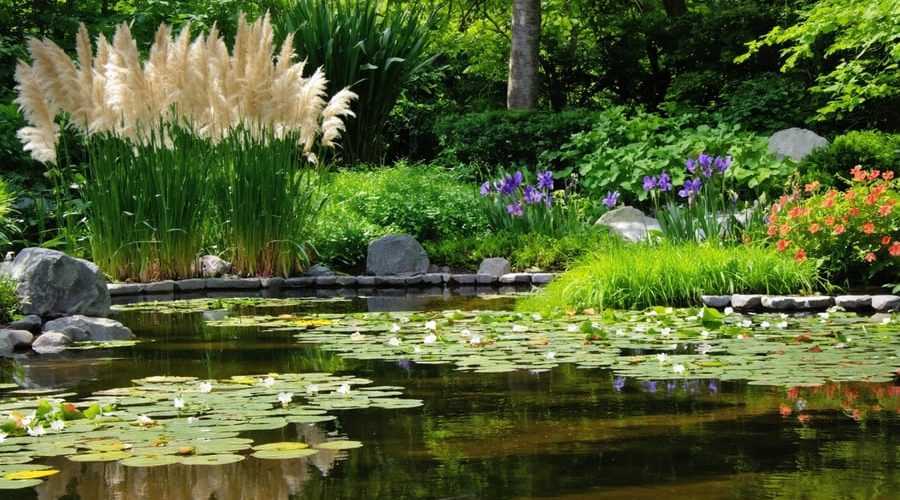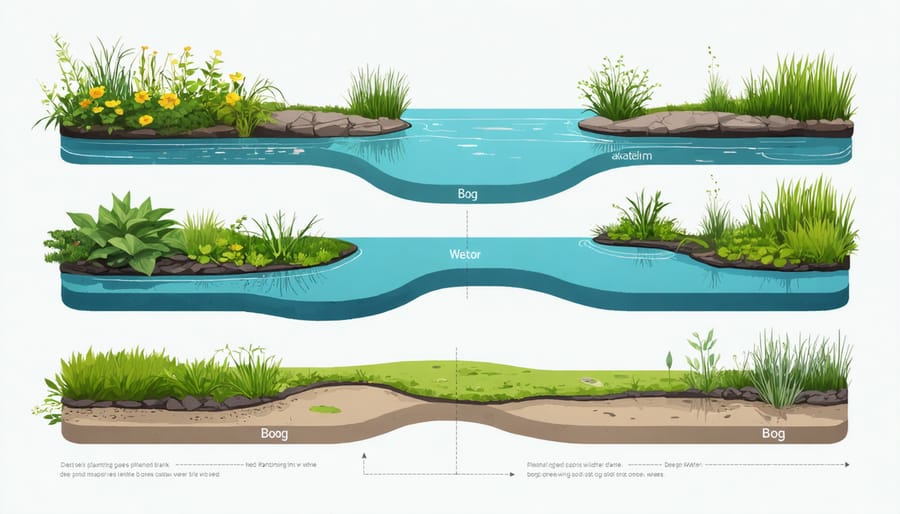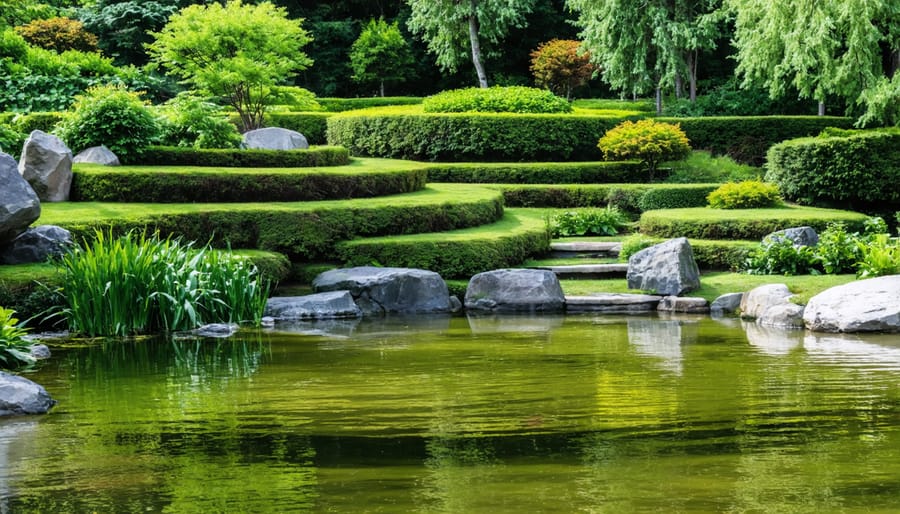
Transform Your Pond into a Living Canvas: Smart Planting Secrets for Natural Beauty
Transform your pond’s surroundings into living art with water features by strategically planting in distinct zones. Create a natural transition from water to land using moisture-loving marginal plants like iris and rushes in the shallow edges. Establish depth with tall backdrop plants such as ornamental grasses and joe-pye weed, while keeping their aggressive root systems in check with submerged barriers. Layer shorter plants like creeping jenny and marsh marigolds in the foreground to prevent erosion and provide year-round interest. Remember to maintain clear sight lines to your pond’s focal points and ensure adequate sunlight reaches the water. This thoughtful arrangement not only stabilizes your pond’s ecosystem but also creates a seamless blend between your water feature and the surrounding landscape.

Planning Your Pond’s Plant Zones
Marginal Zone Plants
Marginal zone plants thrive in shallow water and moist soil around your pond’s edges, creating a seamless transition between water and land. These plants not only look beautiful but also help stabilize the pond’s banks and provide essential habitat for wildlife.
Popular choices include iris, rush, and cattails, which add vertical interest with their striking foliage. For colorful blooms, consider marsh marigolds, which produce cheerful yellow flowers in spring, or purple loosestrife for summer color. These plants typically grow best in water depths between 0-6 inches.
When planting marginal species, use aquatic baskets filled with heavy garden soil or aquatic compost. Place taller varieties at the back of your pond, with shorter plants in front to create depth and visual interest. Space plants about 12-18 inches apart to allow room for growth.
Remember that some marginal plants can be vigorous growers. Control their spread by planting them in containers and trimming back as needed. This helps maintain the perfect balance between natural beauty and controlled garden design.
Bog Garden Zone
The bog garden zone creates a seamless transition between your pond and the surrounding landscape, thriving in consistently moist soil. This area is perfect for plants that love wet feet but don’t need to be submerged. To create a bog garden, dig a shallow depression around parts of your pond, line it with pond liner, and puncture small drainage holes to maintain proper moisture levels without becoming waterlogged.
Popular bog plants include iris, marsh marigold, and Japanese primrose, which add vibrant splashes of color throughout the growing season. Consider incorporating cardinal flower for attracting hummingbirds and joe-pye weed for butterflies. Plant these moisture-lovers in rich, organic soil mixed with plenty of compost.
When designing your bog garden, arrange plants in naturalistic groupings, with taller specimens like filipendula and ligularia toward the back and shorter plants like creeping jenny in the front. Remember to maintain adequate spacing between plants, as they’ll grow fuller in these ideal conditions. Regular mulching with organic material helps retain moisture and suppress weeds while adding to the natural appearance of your bog garden.
Creating Visual Impact with Plant Selection
Height and Texture Combinations
Creating visual interest around your pond is all about layering plants of different heights and incorporating natural textures. Start with tall background plants like ornamental grasses or bamboo, which can reach heights of 4-6 feet, creating a stunning backdrop while offering privacy. These taller plants also provide shelter for wildlife and help frame your pond beautifully.
In the middle ground, add medium-height plants ranging from 2-3 feet tall. Consider day lilies, iris, or compact shrubs that won’t overshadow shorter specimens. This middle layer helps create a smooth transition between tall and ground-level plants while adding depth to your pond landscape.
For the foreground, incorporate low-growing plants like creeping Jenny, sedums, or moss. These ground-huggers soften edges and create an inviting transition between your lawn and pond. Mix plants with different leaf shapes and sizes – broad leaves alongside fine, feathery foliage creates exciting contrasts that catch the eye.
Don’t forget to include various textures throughout each layer. Combine soft, billowing plants with sturdy, architectural specimens. For example, pair the delicate fronds of Japanese forest grass with the bold leaves of hostas. This thoughtful combination of heights and textures creates a natural-looking, multi-dimensional landscape that feels both designed and effortlessly wild.

Year-Round Interest
Creating a pond that captivates throughout the year requires thoughtful plant selection and strategic placement. Start by incorporating evergreen plants like Rush and Carex species that maintain their structure even in winter. These provide a constant backdrop while other plants cycle through their seasonal displays.
For spring interest, include early bloomers like Marsh Marigolds and Japanese Iris, which burst into color just as the garden awakens. Summer brings abundant options, from the dramatic height of Purple Loosestrife to the delicate flowers of Water Forget-me-nots. Consider adding sculptural elements like ornamental grasses that sway gracefully in summer breezes and maintain their presence through winter.
Fall colors can be achieved with Japanese Maple trees or Red Twig Dogwood, which offer brilliant autumn foliage. These same plants continue to provide interest in winter through their distinctive bark or branch structures. Include plants with interesting seed heads, like Joe Pye Weed, which not only look striking when frosted but also provide food for winter birds.
Layer your plantings by height and bloom time, ensuring something catches the eye in every season. Don’t forget to incorporate some marginal plants that die back completely – their emergence in spring becomes a delightful annual event that marks the changing of seasons around your pond.
Essential Maintenance Tips

Seasonal Care Requirements
Each season brings unique care requirements for your pond plantings. In spring, remove dead foliage and divide overgrown plants before new growth begins. This is also the perfect time to add fresh soil and fertilizer to your marginal plants. Watch for emerging shoots and protect them from late frosts with garden fleece if necessary.
Summer is all about maintaining healthy growth. Regular deadheading encourages continuous blooming, while trimming back aggressive spreaders keeps them in check. Keep an eye on water levels, as summer heat increases evaporation. Deep-water plants may need additional fertilizer tablets during this peak growing season.
Fall calls for cutting back dying foliage and removing fallen leaves before they sink and decompose in the water. Tropical plants should be moved indoors before the first frost, while hardy varieties can be trimmed and left in place.
Winter requires minimal maintenance, but protection is key. Cover tender plants with burlap or straw, and use a pond net to catch falling leaves. If your pond freezes, avoid breaking the ice as this can shock the plants. Instead, use a floating de-icer to maintain a small opening for gas exchange.
Remember to adjust your maintenance schedule based on your local climate and the specific needs of your chosen plants.
Managing Plant Growth
Managing the growth of plants around your pond is crucial for maintaining both beauty and balance in your water garden. Regular monitoring and maintenance will help prevent aggressive species from taking over while ensuring all plants thrive in harmony.
Start by spacing plants appropriately when first planting, following the mature size guidelines on plant labels. Remember that many aquatic and marginal plants can spread rapidly, so give them room to grow without overcrowding their neighbors.
Divide spreading plants every 2-3 years in spring to control their size and maintain healthy growth. This is particularly important for vigorous species like cattails and iris. When dividing, remove the plant carefully, split it into smaller sections, and replant only what you need – you can share extra divisions with fellow gardeners!
Use submerged planting baskets with barriers to contain aggressive root systems, especially for plants like water lilies and lotus. These baskets help prevent plants from spreading beyond their designated areas while still allowing them to flourish.
Regularly trim back overhanging vegetation and remove dead foliage to prevent debris from falling into the pond. This not only keeps your pond looking tidy but also helps maintain water quality and prevents excess organic matter buildup.
Problem-Solving Through Smart Planting
Smart planting isn’t just about aesthetics – it’s a powerful tool for solving common pond problems naturally. Strategic plant placement can help you enhance your water feature while addressing several challenges that pond owners frequently face.
Struggling with algae? Consider adding more floating plants like water lilies, which shade the water and reduce sunlight penetration. This natural approach helps control algae growth without chemicals. For murky water issues, submerged oxygenating plants like hornwort work wonders by filtering excess nutrients and improving water clarity.
Bank erosion can be effectively managed by planting deep-rooted marginal plants along the pond’s edge. Plants like iris and rush develop extensive root systems that hold soil in place and prevent shoreline deterioration. For privacy concerns, tall marginal plants like cattails or bamboo create natural screens while adding vertical interest to your pond landscape.
If you’re dealing with unwanted wildlife visitors, certain plants can help deter them. For instance, mint and lavender planted around the pond’s perimeter naturally repel mosquitoes, while thorny plants can discourage herons from fishing in your pond. To manage water temperature fluctuations, combine floating plants for surface shade with tall marginals that provide side protection.
Remember that plants are your allies in maintaining pond health. They not only solve practical problems but also create a more balanced ecosystem. Start with one problem area and gradually expand your plant selection as you become more comfortable with pond gardening. The key is choosing the right plants for your specific challenges while maintaining a harmonious overall design.
Creating a beautiful pond garden is an rewarding project that transforms your outdoor space into a thriving ecosystem. By carefully selecting plants for each zone – from deep water to bog areas – and following proper planting techniques, you’ll create a natural-looking water feature that provides year-round interest. Remember to balance aesthetics with functionality, choosing a mix of plants that offer both beauty and practical benefits like water filtration and wildlife habitat. Start small, maintain regular care of your pond plants, and don’t be afraid to experiment with different combinations. With proper planning and the right plant choices, your pond garden will become a stunning focal point that brings joy and tranquility to your outdoor space. Take that first step today – your perfect pond garden awaits!
